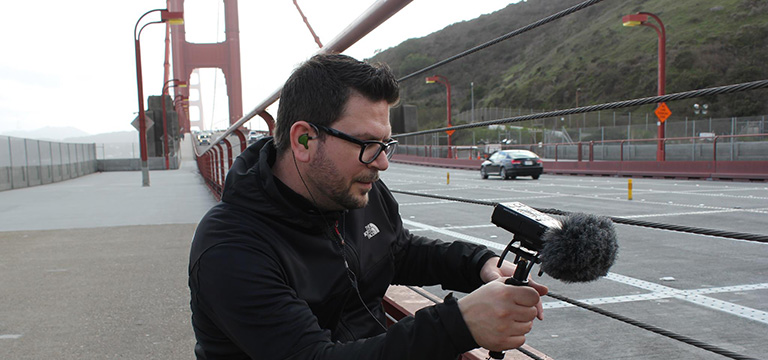Artists :: Ivo Ivanov

BiographySound designer Ivo Ivanov has built custom instruments for some of the biggest names in the business, including Trent Reznor, Derrick Carter, Kero, Otto Von Schirach, Richard Devine and Justin Meldal-Johnsen to name a few. The sound designer works with several libraries, and his sound effects are found in films and video games. Which sound libraries do you record for? I’m the Lead Sound Designer at both Glitchmachines and Inear Display. Both are boutique sample library and plugin companies that share a similar aesthetic vision. I have also been working closely with Twisted Tools, with whom I’ve released numerous sound design projects, as well as a full sample library. Most recently, I started working as a Sound Designer with the UK company, Samplephonics. What are game companies looking for in sound effects? Game companies are ultimately looking for unique special effects. I say that because the market is already packed with libraries encompassing the full spectrum in terms of standard sound effects. What’s missing are sounds that truly underline the creativity you see in many of today’s modern games. My goal is to provide developers with content that will not only reinforce their aesthetic vision, but hopefully also inspire them to move further into uncharted territory and push boundaries to evolve the art form itself. Describe your mobile recording rig and microphones. How you chose the DR-100mkII? I have a TASCAM DR-100mkII, Sound Devices 702, Schoeps CMIT-5U, and a Sennheiser MKH 8060 that I usually take into the field. I reference with a set of JH16Pro in ear monitors from JH Audio. I chose the TASCAM for various reasons. Most importantly, it sounds absolutely phenomenal. Compared to other recorders in its class, it outshines everything else that I’ve tested – and I have practically tested them all. Of equal importance is the superb build quality. The unit really is built like a tank – it feels and works like a professionally piece of equipment. Last but certainly not least, are the features and overall convenience factors. For such an affordable piece of equipment, you get some very important features such as 96kHz recording, dual battery system, and a very-well thought out and responsive operating system, to name a few. In terms of convenience, I take this unit with me virtually everywhere I go. I do so partly because it can fit inside my jacket pocket, and partly because I am fully confident in the unit’s ability to capture high quality recordings that will not sound out of place with the stuff I’ve captured with my higher end gear. Are you using the recorder in your classes at SAE? How is it used? I use it in my classes at SAE whenever I talk about field recording and sound design. I don’t even bring any other gear since it’s honestly not even relevant to the students. Once I show the students how fantastic the DR-100mkII recorder sounds, they immediately see the light. And the best part is that it’s so reasonably priced, it’s actually attainable. I can’t count the number of times students (and colleagues) have asked me to recommend a portable recorder. After a brief technical explanation to make my case, I send them on their way to obtain the obvious choice; the DR-100mkII. Are there any recent sound recording projects that stand out? I just finished up recordings for an upcoming Glitchmachines project. The DR-100mkII was heavily used on this project, as it was far more up to the task then my other gear. This project is focused on unusual sounds captured by recording electromagnetic fields inside all manner of electronic devices such as scanners, blenders, tools, studio equipment, cars and other vehicles, cameras, and much more. I used a pair of electromagnetic pickup mics to capture these recordings with the TASCAM. I also recently took the TASCAM out into the field to record some sounds with a pair of contact mics. One particular highlight in these sessions was recording a variety of vibrations from the old bunkers near the Golden Gate Bridge in the San Francisco/Marin area. I’ve made extensive use of the DR-100mkII on my Biomorph library. In fact, I would say approximately a third of the final sounds were all recorded with the unit! Given the high level of detail in these sound effects, I would argue that there is no better way to illustrate the capability of this fantastic recorder. I’ve also used the DR-100mkII on nearly every other project I’ve released with Glitchmachines. As I mentioned earlier, the unit goes with me nearly everywhere I go, and I never have to worry about reliability, functionality or audio quality. Do you use any TASCAM gear in the studio? I’ve used an exhaustive list of TASCAM gear over the last 20+ years. At SAE, we have a DM-4800, which is an important part of our Audio Technology Program. I’ve personally owned numerous TASCAM DAT recorders, including an old favorite: the DAP-1. How did you get started in audio? Any tips for beginners? I got started back in the late eighties, after being heavily influenced by an eclectic mix of classical music, electro, rock and heavy metal, and early hip hop. The common thread across all of these genres that inspired me to pursue music production was their unique sonic landscape, intellectual themes, and stylized aesthetics. I was 13 or 14 when I started to learn about audio recording and synthesis. In those days, we didn’t have the luxury of the Internet, so I did as much reading as humanly possible and made slow, steady progress. The biggest tip I can give to a beginner is to embrace the challenge and learn as much as you can. Don’t look for instant gratification – take an academic approach to learning your craft and make a long-term commitment. |
Background Information
|